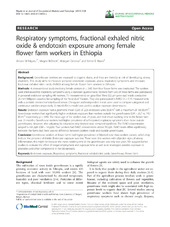| dc.contributor.author | Nigatu, Amare Workiye | en_US |
| dc.contributor.author | Bråtveit, Magne | en_US |
| dc.contributor.author | Deressa, Wakgari | en_US |
| dc.contributor.author | Moen, Bente E. | en_US |
| dc.date.accessioned | 2015-03-20T07:49:54Z | |
| dc.date.available | 2015-03-20T07:49:54Z | |
| dc.date.issued | 2015-02-26 | eng |
| dc.identifier.issn | 1745-6673 | |
| dc.identifier.uri | https://hdl.handle.net/1956/9597 | |
| dc.description.abstract | Background: Greenhouse workers are exposed to organic dusts, and they are thereby at risk of developing airway disorders. This study aims to measure personal endotoxin exposure, assess respiratory symptoms and measure fractional exhaled nitric oxide (FeNO) among female flower farm workers in Ethiopia. Methods: A cross-sectional study involving female workers (n = 248) from four flower farms was conducted. The workers were interviewed for respiratory symptoms using a standard questionnaire. Workers from two of these farms also participated in personal endotoxin sampling (46 workers, 75 measurements) on glass fiber filters (0.2 μm pore size) inside conductive 25 mm Millipore cassettes for sampling of the “total dust” fraction. They also participated in FeNO (n = 114) measurements with a portable electrochemistry-based sensor. Chi-square and independent t-tests were used to compare categorical and continuous variables respectively. A mixed-effects model was used to analyze exposure determinants. Results: Endotoxin exposure had a geometric mean (GM) of 22.8 endotoxin units (EU)/m3 with a maximum of 180 EU/m3. Greenhouse workers had significantly higher endotoxin exposure than workers outside the greenhouses (GM= 26.7 vs. 19.3 EU/m3 respectively; p < 0.05). The mean age of the workers was 24 years, and their mean working time in the flower farm was 21 months. Greenhouse workers had higher prevalence of self-reported respiratory symptoms than those outside greenhouses. However, after adjusting for education only blocked nose remained significant. The FeNO concentration ranged 5–166 ppb (GM = 14 ppb). Two workers had FeNO concentration above 50 ppb. FeNO levels differs significantly between the farms but there was no difference between workers inside and outside greenhouses. Conclusion: Greenhouse workers at flower farms had higher prevalence of blocked nose than workers outside, which may indicate the presence of rhinitis. Endotoxin exposure was low. There were few workers with objective signs of airway inflammation; this might be because the mean working time in the greenhouses was only two years. We suggest further studies to evaluate the effect of longer employment and exposure time as well as to investigate possible exposure to pesticides and other components in the bio-aerosols. | en_US |
| dc.language.iso | eng | eng |
| dc.publisher | BioMed Central | eng |
| dc.relation.ispartof | <a href="http://hdl.handle.net/1956/16126" target="_blank">Respiratory health and acute pesticide intoxications among workers in the flower farm industry in Ethiopia</a> | |
| dc.rights | Attribution CC BY | eng |
| dc.rights.uri | http://creativecommons.org/licenses/by/4.0/ | eng |
| dc.subject | endotoxin exposure | eng |
| dc.subject | respiratory symptoms | eng |
| dc.subject | fractional exhaled nitric oxide | eng |
| dc.subject | greenhouses | eng |
| dc.subject | flower farms | eng |
| dc.title | Respiratory symptoms, fractional exhaled nitric oxide & endotoxin exposure among female flower farm workers in Ethiopia | en_US |
| dc.type | Peer reviewed | |
| dc.type | Journal article | |
| dc.date.updated | 2015-03-09T10:42:50Z | en_US |
| dc.description.version | publishedVersion | en_US |
| dc.rights.holder | Copyright 2015 Nigatu et al.; licensee BioMed Central. | |
| dc.source.articlenumber | 8 | |
| dc.identifier.doi | https://doi.org/10.1186/s12995-015-0053-x | |
| dc.identifier.cristin | 1230451 | |
| dc.source.journal | Journal of Occupational Medicine and Toxicology | |
| dc.source.40 | 10 | |

